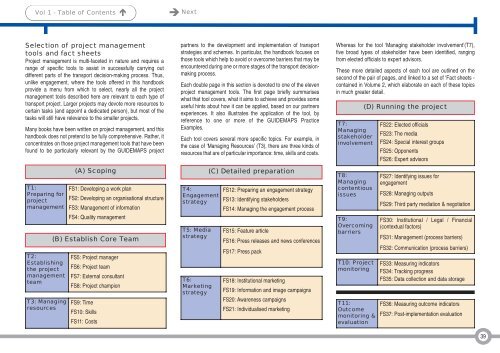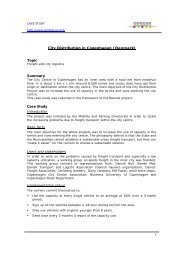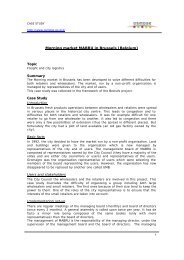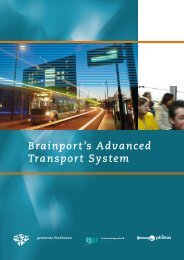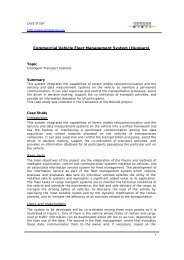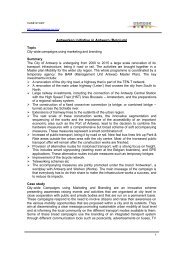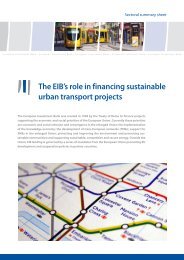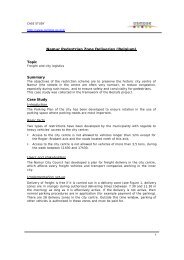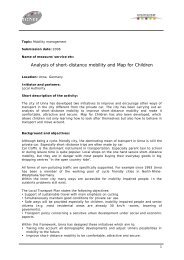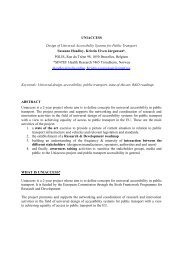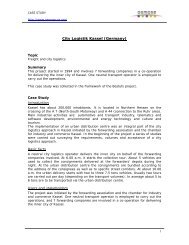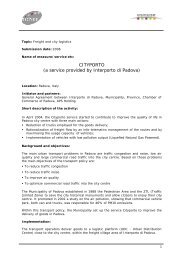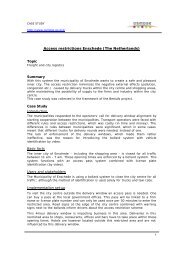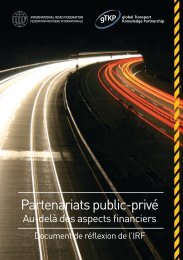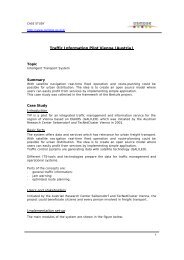Successful transport decision-making - Osmose
Successful transport decision-making - Osmose
Successful transport decision-making - Osmose
Create successful ePaper yourself
Turn your PDF publications into a flip-book with our unique Google optimized e-Paper software.
Vol 1 - Table of Contents <br />
Next<br />
Selection of project management<br />
tools and fact sheets<br />
Project management is multi-faceted in nature and requires a<br />
range of specific tools to assist in successfully carrying out<br />
different parts of the <strong>transport</strong> <strong>decision</strong>-<strong>making</strong> process. Thus,<br />
unlike engagement, where the tools offered in this handbook<br />
provide a menu from which to select, nearly all the project<br />
management tools described here are relevant to each type of<br />
<strong>transport</strong> project. Larger projects may devote more resources to<br />
certain tasks (and appoint a dedicated person), but most of the<br />
tasks will still have relevance to the smaller projects.<br />
Many books have been written on project management, and this<br />
handbook does not pretend to be fully comprehensive. Rather, it<br />
concentrates on those project management tools that have been<br />
found to be particularly relevant by the GUIDEMAPS project<br />
T1:<br />
Preparing for<br />
project<br />
management<br />
T2:<br />
Establishing<br />
the project<br />
management<br />
team<br />
T3: Managing<br />
resources<br />
(A) Scoping<br />
FS1: Developing a work plan<br />
FS2: Developing an organisational structure<br />
FS3: Management of information<br />
FS4: Quality management<br />
(B) Establish Core Team<br />
FS5: Project manager<br />
FS6: Project team<br />
FS7: External consultant<br />
FS8: Project champion<br />
FS9: Time<br />
FS10: Skills<br />
FS11: Costs<br />
partners to the development and implementation of <strong>transport</strong><br />
strategies and schemes. In particular, the handbook focuses on<br />
those tools which help to avoid or overcome barriers that may be<br />
encountered during one or more stages of the <strong>transport</strong> <strong>decision</strong><strong>making</strong><br />
process.<br />
Each double page in this section is devoted to one of the eleven<br />
project management tools. The first page briefly summarises<br />
what that tool covers, what it aims to achieve and provides some<br />
useful hints about how it can be applied, based on our partners<br />
experiences. It also illustrates the application of the tool, by<br />
reference to one or more of the GUIDEMAPS Practice<br />
Examples.<br />
Each tool covers several more specific topics. For example, in<br />
the case of ‘Managing Resources’ (T3), there are three kinds of<br />
resources that are of particular importance: time, skills and costs.<br />
T4:<br />
Engagement<br />
strategy<br />
T5: Media<br />
strategy<br />
T6:<br />
Marketing<br />
strategy<br />
(C) Detailed preparation<br />
FS12: Preparing an engagement strategy<br />
FS13: Identifying stakeholders<br />
FS14: Managing the engagement process<br />
FS15: Feature article<br />
FS16: Press releases and news conferences<br />
FS17: Press pack<br />
FS18: Institutional marketing<br />
FS19: Information and image campaigns<br />
FS20: Awareness campaigns<br />
FS21: Individualised marketing<br />
Whereas for the tool ‘Managing stakeholder involvement’(T7),<br />
five broad types of stakeholder have been identified, ranging<br />
from elected officials to expert advisors.<br />
These more detailed aspects of each tool are outlined on the<br />
second of the pair of pages, and linked to a set of ‘Fact sheets -<br />
contained in Volume 2, which elaborate on each of these topics<br />
in much greater detail.<br />
T7:<br />
Managing<br />
stakeholder<br />
involvement<br />
T8:<br />
Managing<br />
contentious<br />
issues<br />
T9:<br />
Overcoming<br />
barriers<br />
T10: Project<br />
monitoring<br />
T11:<br />
Outcome<br />
monitoring &<br />
evaluation<br />
(D) Running the project<br />
FS22: Elected officials<br />
FS23: The media<br />
FS24: Special interest groups<br />
FS25: Opponents<br />
FS26: Expert advisors<br />
FS27: Identifying issues for<br />
engagement<br />
FS28: Managing outputs<br />
FS29: Third party mediation & negotiation<br />
FS30: Institutional / Legal / Financial<br />
(contextual factors)<br />
FS31: Management (process barriers)<br />
FS32: Communication (process barriers)<br />
FS33: Measuring indicators<br />
FS34: Tracking progress<br />
FS35: Data collection and data storage<br />
FS36: Measuring outcome indicators<br />
FS37: Post-implementation evaluation<br />
39


